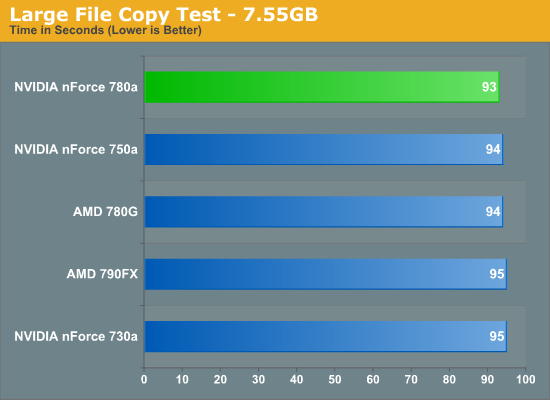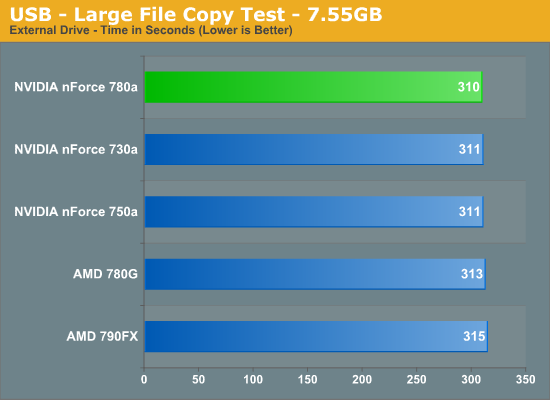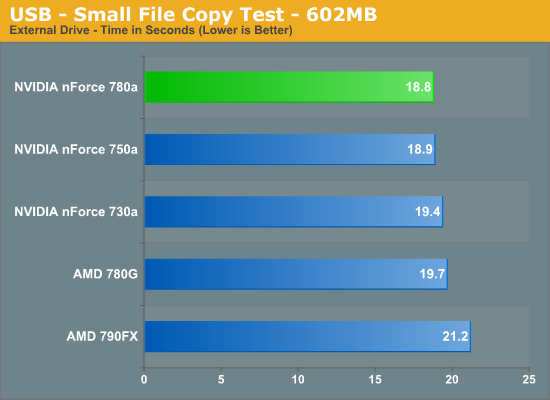NVIDIA 780a: Integrated Graphics and SLI in One
by Gary Key on May 6, 2008 12:00 AM EST- Posted in
- CPUs
Southbridge Performance
In our hard drive transfer tests, we copy our two folders from our source drive to an identical target drive to test the transfer speed of the disk controller. Our 780a board has the fastest transfer rates although the SB600 on the 790FX and SB700 on the 780G products keep pace with the NVIDIA offerings.


We utilized a Maxtor One Touch external 300GB drive for our USB 2.0 transfer tests that feature the same file folders used in our hard drive transfer test. This particular setup has support for Firewire 400, Firewire 800, and USB 2.0. Our Firewire tests are dependent on the IEEE 1394 chipset utilized and will be covered in the motherboard review.


Historically, NVIDIA and Intel have had very good USB performance compared to AMD/ATI. AMD finally addressed USB performance concerns with the SB600 although performance still lags compared to other chipsets. The SB700 utilized on the 780G boards offered additional performance improvements and is about on par with Intel and NVIDIA now.
The SB600 equipped 790FX board trails the NVIDA and SB700 equipped 780G slightly in our transfer tests. Overall, the differences are fairly minor in actual usage and will not be noticed by users.










38 Comments
View All Comments
wjl - Wednesday, May 7, 2008 - link
I tried a Wolfdale 2,6GHz (E8200) with Intel's G35, and it's an improvement already - tho for "serious" HTPC usage, I would probably wait for the G45, which should be out this summer.Sure, Intel chip sets are not flawless, like their drivers also. But Intel and AMD are moving into the right direction, and I wish this would be honoured more when comparison tests like the one here are performed.
The world isn't only Windows, and only gamers - wake up guys. Take the Phoronix test suite if you have to compare and show numbers. I think even this test suite is GPL'ed, so...
Anyway: the ATI/AMD 690G (RS690) will work now with 3D, using only open source drivers - and it's news like these which are really important for the rest of us - not which newest chip set has a few frames per second more or less, which is really ONLY interesting for first person shooters.
Natfly - Tuesday, May 6, 2008 - link
How important is HT3 for the IGP? Is 1080P content watchable without it?
Also, is there an equivalent to AMD's sideport memory that may show up in some 780a/8200 boards?
derek85 - Tuesday, May 6, 2008 - link
HT3 is most important when you watch interlaced contents (1080i) because of the extra HDHQV features require alot more bandwidth than normal 1080p. Theoratically 1080p should be watchable without HT3, but this largely depends on the K8 model you get.I'm not sure about sideport equivalence from NVIDIA, I haven't heard anything related to it and I highly doubt they will be able to come up with one, because that requires modification of their existing blocks which they probably won't bother to spend the time on. If you really want that, just get an AMD board ;)
Natfly - Tuesday, May 6, 2008 - link
Well I was planning on getting a 4850e and have been recently trying to decide between the 780G and 8200. I'd like to get the best IGP performance and also have RAID5 w/out using any extra cards, but that seems impossible at this point. Maybe a manufacturer will pair up 780G with SB750 when it gets released.derek85 - Thursday, May 8, 2008 - link
If you want to max out 3D performance, HT3 is the way to go. HT1 can provide maximum 8GB of bandwidth, HT3 with 1800MHz can provide 14.4GB of bandwidth (2 channel DDR2-800 is 12.8GB). The actual improvement of this reflected in benchmarks such as 3DMarko6 is quite significant (>20%), but nonetheless it is still IGP, so whether you would like to invest more into it is totally up to you.Von Matrices - Tuesday, May 6, 2008 - link
Is my PC at fault or does anyone else notice the horrible compression of the charts on page 6?JarredWalton - Tuesday, May 6, 2008 - link
Fixed... Gary changed the chart sizes but didn't update the HTML (where a smaller width and height was hard-coded). Shame on him. I have had him flogged with a Cat-o-nine-SATA-cords.Mgz - Tuesday, May 6, 2008 - link
in page 4 you have a little typo "we can't really be sure until NVIDI confirms the details"homerdog - Tuesday, May 6, 2008 - link
I appreciate the effort by Nvidia to reduce idle power consumption, but I would much rather see a discrete GPU that doesn't draw so much power when idling in first place. ATI has been making significant strides in this department lately with PowerPlay, and EVERY motherboard/configuration benefits. Having two GPUs with redundant framebuffers is going around your elbow to get to your ******* if you ask me.ChrisRay - Tuesday, May 6, 2008 - link
HomerDog. Not sure I entirely understand your problem with Hybrid Power. Its basically a technology that lets you shut of your discreet GPUS completely. No amount of power saving tech is going to have that measure of impact. ((Or system noise impact)).Your right that every motherboard benefits from power saving tech on discreet GPUs. But the difference in power saving by using a feature like Hybrid power is huge compared to any idle technology existing on GPUS. Browsing from my desktop with Hybrid Power enabled and Quad SLI 9800GX2. My AVG room temp went down 4-5C after 2 hours of web activity from having hybrid power enabled. Thats significant.
SLIZONE Forum Admin.
Nvidia User Group